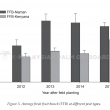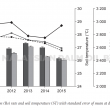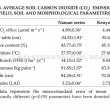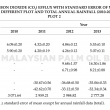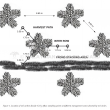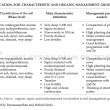Journal of Oil Palm Research Vol. 33 (2) June 2021, p. 257-266
SOIL CARBON DIOXIDE (CO2) EFFLUX RATE AND OIL PALM YIELD FROM DIFFERENT PEAT TYPES IN SARAWAK, MALAYSIA
DOI: https://doi.org/10.21894/jopr.2020.0091
Received: 16 May 2019 Accepted: 21 August 2020 Published Online: 22 October 2020
Tropical peatlands have different characteristics as compared to temperate peatlands in terms of organic materials and topography. It is important to understand the soil characteristics for improving crop management practices. A study was conducted to investigate the effects of different types of peat on soil carbon dioxide (CO2 ) emissions and oil palm yield in Sarawak. The study area was classified as Naman (Oa) and Kenyana (Oawu) series using the Malaysian Unified Classification of Organic Soils (MUCOS). Soil CO2 efflux was determined by using a portable CO2 analyser at monthly intervals from eight observational plots setup in each 10 ha study plot. The oil palm fresh fruit bunch (FFB) yield was recorded since the first year of harvest (i.e. after about 30 months field planting). Results showed that the average soil CO2 efflux was the highest in Naman series plot (4.89±0.36 µmol CO2 m-2 s-1) compared to Kenyana series plot (4.44±0.37 µmol CO2 m-2 s-1). However, FFB yield was recorded 40% higher at Naman plot compared to Kenyana plot. Higher FFB yield in Naman plot was related to its soil consisting of sapric materials that have more nutrients available for the crop, while Kenyana plot consisted of sapric materials together with undecomposed wood that might hinder the palm growth. This study suggests that different types of peat have significant effects on oil palm yield and soil CO2 emissions. The site-specific and peat soil management based on its characteristics is important for oil palm growth and performance especially for enhancing FFB yield and improving environmental management.
KEYWORDS:FIGURES & TABLES:
* Malaysian Palm Oil Board,
6 Persiaran Institusi, Bandar Baru Bangi,
43000 Kajang, Selangor, Malaysia.
E-mail: hasimah.mos@mpob.gov.my
** Param Agricultural Soil Surveys (M) Sdn Bhd,
A4-3, Jalan 17/13, 46400 Petaling Jaya,
Selangor, Malaysia.
‡ Soil Division, Department of Agriculture,
Sarawak Soil Division, Department of Agriculture,
Kuching, Sarawak, Malaysia.
‡‡ Environmental Technology,
School of Industrial Technology,
Universiti Sains Malaysia,
11800 USM Pulau Pinang, Malaysia.
